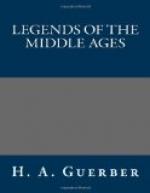A triumphant march through the country then ensued, and Charlemagne returned to France, thinking the Saracens subdued. He had scarcely crossed the border, however, when Aigolandus, one of the pagan monarchs, revolted, and soon recovered nearly all the territory his people had lost. When Charlemagne heard these tidings, he sent back an army, commanded by Milon, Roland’s father, who perished gloriously in this campaign. The emperor speedily followed his brother-in-law with great forces, and again besieged Aigolandus in Pamplona. During the course of the siege the two rulers had an interview, which is described at length, and indulged in sundry religious discussions, which, however, culminated in a resumption of hostilities. Several combats now took place, in which the various heroes greatly distinguished themselves, the preference being generally given to Roland, who, if we are to believe the Italian poet, was as terrible in battle as he was gentle in time of peace.
“On stubborn foes he vengeance
wreak’d,
And laid about him like a Tartar;
But if for mercy once they squeak’d,
He was the first to grant them quarter.
The battle won, of Roland’s soul
Each milder virtue took possession;
To vanquished foes he o’er a bowl
His heart surrender’d at discretion.”
ARIOSTO, Orlando Furioso
(Dr. Burney’s tr.).
Aigolandus being slain, and the feud against him thus successfully ended, Charlemagne carried the war into Navarre, where he was challenged by the giant Ferracute (Ferragus) to meet him in single combat. Although the metrical “Romances” describe Charlemagne as twenty feet in height, and declare that he slept in a hall, his bed surrounded by one hundred lighted tapers and one hundred knights with drawn swords, the emperor felt himself no match for the giant, whose personal appearance was as follows:—
“So hard he was to-fond [proved],
That no dint of brond
No grieved him, I plight.
He had twenty men’s strength;
And forty feet of length
Thilke [each] paynim had;
And four feet in the face
Y-meten [measured] on the place;
And fifteen in brede [breadth].
His nose was a foot and more;
His brow as bristles wore;
(He that saw it said)
He looked lothliche [loathly],
And was swart [black] as pitch;
Of him men might adrede!”
Roland and Ferragus.
[Sidenote: Roland and Ferracute.] After convincing himself of the danger of meeting this adversary, Charlemagne sent Ogier the Dane to fight him, and with dismay saw his champion not only unhorsed, but borne away like a parcel under the giant’s arm, fuming and kicking with impotent rage. Renaud de Montauban met Ferracute on the next day, with the same fate, as did several other champions. Finally Roland took the field, and although the giant pulled him down from his horse, he continued the battle all day. Seeing that his sword Durandana had no effect upon Ferracute, Roland armed himself with a club on the morrow.




